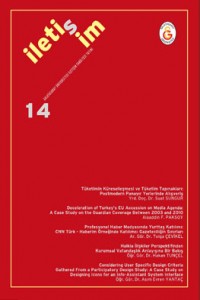Öz
Anahtar Kelimeler
Kaynakça
- BERGER John and MOHR Jean (1982), Another Way of Telling. London, Writers and Readers Publishing.
- CHALFEN Richard (1988), Snapshot Versions of Life, Bowling Green, OH, Bowling Green State University Popular Press.
- de CERTEAU Michel (1996), Practice of Everyday Life, Berkeley, University of California Press.
- GINSBURG Faye (1995), "The Parallax Effect: The Impact of Aboriginal Media on Ethnographic Film". Visual Anthropology Review, 11(2), 64-76.
- GINSBURG Faye (1991), “Indigenous Media: Faustian Contract or Global Village?” Cultural Anthropology 6/1 (February): 92-112.
- MacDOUGALL David (1991), "Whose Story Is It?". Visual Anthropology Review, 7: 2-10.
- MORAN James M. (2002), There's no place like home video, University of Minnesota Press. ODIN Roger (1995), “Le film de famille dans l’institution familiale” in Le film de famille, usage privé, usage public, R. Odin (dir.), Paris, Méridiens-Klincksieck. PRATT Mary Louise (1991), "Arts of the contact zone". Profession, 33-40.
- RUBY Jay (1991), "Speaking For, Speaking About, Speaking With, or Speaking Alongside An Anthropological and Documentary Dilemma". Visual Anthropology Review, 7(2), 50-67.
Öz
Depuis les années 1980, la production des vidéos de mariage est devenue une partie inséparable des cérémonies nuptiales. Transformés à un rituel dans un autre rituel, de notre point de vue ces vidéos sont plus que les documents de l’histoire de la famille ; ils satisfont à certains besoins culturels de ceux qui les pratiquent. Dans notre monde contemporain, l’immigration est une expérience sociale déterminante et ces vidéos peuvent être un moyen pour interrelier les cultures d’accueil et d’origine. Ce papier a le but d’explorer les traces d’une telle relation à travers l’étude du processus de tournage d’une vidéo particulière concernant un mariage turc à Paris.
Anahtar Kelimeler
mot-clés: film de mariage film ethnographique home mode communication zones de contact anthropologie visuelle
Kaynakça
- BERGER John and MOHR Jean (1982), Another Way of Telling. London, Writers and Readers Publishing.
- CHALFEN Richard (1988), Snapshot Versions of Life, Bowling Green, OH, Bowling Green State University Popular Press.
- de CERTEAU Michel (1996), Practice of Everyday Life, Berkeley, University of California Press.
- GINSBURG Faye (1995), "The Parallax Effect: The Impact of Aboriginal Media on Ethnographic Film". Visual Anthropology Review, 11(2), 64-76.
- GINSBURG Faye (1991), “Indigenous Media: Faustian Contract or Global Village?” Cultural Anthropology 6/1 (February): 92-112.
- MacDOUGALL David (1991), "Whose Story Is It?". Visual Anthropology Review, 7: 2-10.
- MORAN James M. (2002), There's no place like home video, University of Minnesota Press. ODIN Roger (1995), “Le film de famille dans l’institution familiale” in Le film de famille, usage privé, usage public, R. Odin (dir.), Paris, Méridiens-Klincksieck. PRATT Mary Louise (1991), "Arts of the contact zone". Profession, 33-40.
- RUBY Jay (1991), "Speaking For, Speaking About, Speaking With, or Speaking Alongside An Anthropological and Documentary Dilemma". Visual Anthropology Review, 7(2), 50-67.
Öz
1980’lerden itibaren düğün ritüeli içinde yer almaya başlayan ve günümüzde düğün törenlerinin ayrılmaz bir parçası olarak bir alt ritüele dönüşen düğün videoları, aile tarihçesi açısından önemli belgeler olmalarının ötesinde, kullanıcıları açısından bazı kültürel gereksinimleri karşılamaktadırlar. Göç olgusunun çok güçlü bir toplumsal belirleyici olduğu günümüz dünyasında, bu videolar farklı kültürler arasında zamansal/mekânsal sınırların ötesinde bir köprü işlevi üstlenirler. Bu sunuşun amacı, Paris’te gerçekleşen bir Türk düğününün video çekim kaşamalarını inceleyerek Türk göçmen aileleri arasında kurulan zamansal/mekansal bağlantıların izlerini takip etmektir.
Anahtar Kelimeler
düğün videoları etnografik film temas bölgeleri görsel iletişim antropolojisi
Kaynakça
- BERGER John and MOHR Jean (1982), Another Way of Telling. London, Writers and Readers Publishing.
- CHALFEN Richard (1988), Snapshot Versions of Life, Bowling Green, OH, Bowling Green State University Popular Press.
- de CERTEAU Michel (1996), Practice of Everyday Life, Berkeley, University of California Press.
- GINSBURG Faye (1995), "The Parallax Effect: The Impact of Aboriginal Media on Ethnographic Film". Visual Anthropology Review, 11(2), 64-76.
- GINSBURG Faye (1991), “Indigenous Media: Faustian Contract or Global Village?” Cultural Anthropology 6/1 (February): 92-112.
- MacDOUGALL David (1991), "Whose Story Is It?". Visual Anthropology Review, 7: 2-10.
- MORAN James M. (2002), There's no place like home video, University of Minnesota Press. ODIN Roger (1995), “Le film de famille dans l’institution familiale” in Le film de famille, usage privé, usage public, R. Odin (dir.), Paris, Méridiens-Klincksieck. PRATT Mary Louise (1991), "Arts of the contact zone". Profession, 33-40.
- RUBY Jay (1991), "Speaking For, Speaking About, Speaking With, or Speaking Alongside An Anthropological and Documentary Dilemma". Visual Anthropology Review, 7(2), 50-67.
Ayrıntılar
| Birincil Dil | Türkçe |
|---|---|
| Yazarlar | |
| Yayımlanma Tarihi | 1 Haziran 2011 |
| Yayımlandığı Sayı | Yıl 2011 Sayı: 14 |



